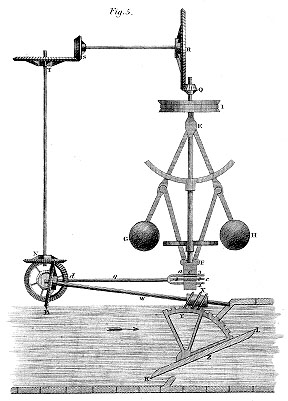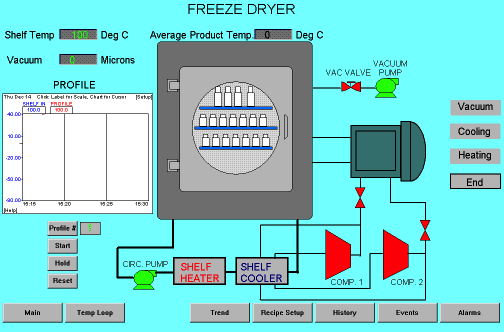History of Automatic Control
Although automatic control has been around in simple forms for thousands of years, it
was the industrial revolution in the late 18th and early nineteenth centuries that really
triggered the development of more complex systems.
 Prior to the industrial revolution, human labour was
the main mechanism of industry and every human came complete with its own biological control
system! As machines started to replace humans it became clear that automatic mechanisms
were required to regulate them. The most famous of the industrial revolution control
devices is the Watt Flyball Governor, invented by James Watt to control the speed of steam
engines.
Prior to the industrial revolution, human labour was
the main mechanism of industry and every human came complete with its own biological control
system! As machines started to replace humans it became clear that automatic mechanisms
were required to regulate them. The most famous of the industrial revolution control
devices is the Watt Flyball Governor, invented by James Watt to control the speed of steam
engines.
Machines and their accompanying control systems developed into the twentieth century,
but they tended to be designed on a relatively ad-hoc basis with little unifying theory.
This changed completely during the Second World War when control systems were pressed into
military service. The theory of automatic control developed rapidly during the war and led
to the development of highly advanced weapon control systems (Anti-aircraft gunsights,
Ballistic missile control systems, Bomb sights, etc).
Along with control systems, process plant design also developed during the early part of
the twentieth century. At the start of the century chemical production largely occurred in
batch processes, most of which were simply large tanks were reactants were added and mixed
together. These simple processes were relatively simple to control (most didn't have much
that could be controlled - it was simply a case of getting the proportions right and
hoping for the best!). As time moved on, however, processes became more sophisticated and
more and more continuous process plants came into service. After the second world war
almost all process plants had some form of automatic control fitted (based around
pneumatic systems - the controller was a mechanical device which used air pressure as a
communication and calculation medium).
 In the late fifties the transistor started to come
into industrial use, followed by integrated circuit technology. This led to the move away
from pneumatic controllers to electronic systems (except in applications in highly
flammable areas). This continued through the 1960's and 70's. By the early 1980's computer
systems became cheap and powerful enough to use as process control systems (computers were
tried, unsuccessfully, in the 1960's) and discrete electronic controllers began to be
partially replaced.
In the late fifties the transistor started to come
into industrial use, followed by integrated circuit technology. This led to the move away
from pneumatic controllers to electronic systems (except in applications in highly
flammable areas). This continued through the 1960's and 70's. By the early 1980's computer
systems became cheap and powerful enough to use as process control systems (computers were
tried, unsuccessfully, in the 1960's) and discrete electronic controllers began to be
partially replaced.
The situation today is one where computers largely dominate the process control scene.
These computers are either at a higher, supervisory, level and look a bit like a normal PC
(i.e. they have a keyboard and screen), or they can be embedded inside a low level
controller.
 Some
Web resources on the history of automatic control. The American Institution of Electrical
and Electronic Engineers. A handy chart with
dates. Three interesting, but kind of weird, pages: page 1, page 2, page 3
Some
Web resources on the history of automatic control. The American Institution of Electrical
and Electronic Engineers. A handy chart with
dates. Three interesting, but kind of weird, pages: page 1, page 2, page 3
 Prior to the industrial revolution, human labour was
the main mechanism of industry and every human came complete with its own biological control
system! As machines started to replace humans it became clear that automatic mechanisms
were required to regulate them. The most famous of the industrial revolution control
devices is the Watt Flyball Governor, invented by James Watt to control the speed of steam
engines.
Prior to the industrial revolution, human labour was
the main mechanism of industry and every human came complete with its own biological control
system! As machines started to replace humans it became clear that automatic mechanisms
were required to regulate them. The most famous of the industrial revolution control
devices is the Watt Flyball Governor, invented by James Watt to control the speed of steam
engines. In the late fifties the transistor started to come
into industrial use, followed by integrated circuit technology. This led to the move away
from pneumatic controllers to electronic systems (except in applications in highly
flammable areas). This continued through the 1960's and 70's. By the early 1980's computer
systems became cheap and powerful enough to use as process control systems (computers were
tried, unsuccessfully, in the 1960's) and discrete electronic controllers began to be
partially replaced.
In the late fifties the transistor started to come
into industrial use, followed by integrated circuit technology. This led to the move away
from pneumatic controllers to electronic systems (except in applications in highly
flammable areas). This continued through the 1960's and 70's. By the early 1980's computer
systems became cheap and powerful enough to use as process control systems (computers were
tried, unsuccessfully, in the 1960's) and discrete electronic controllers began to be
partially replaced.